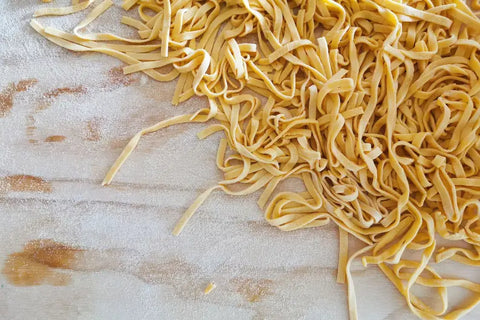Tips for a Healthier Pasta for Type 2 Diabetics

When it comes to nutrition, pasta is a synonym to comfort, which can be terrible considering you should be cautious about carbs as a person with diabetes. And if you have type 2 diabetes, you may have heard that pasta is a food you should avoid.
However, if you enjoy pasta and are ready to make a few changes to the traditional bowl, you may not need to say goodbye to this comfort food. Pasta can be included in a diabetic's healthy meal plan despite its higher carbohydrate content than some other foods.
Pasta Substitutes for Diabetics
Pasta has a lot to offer: the noodles may take on any flavor and provide a satisfying savory sensation. However, pasta is high in carbohydrates or carbs. Consuming too many carbohydrates can lead to inflammation, excess weight, and elevated blood sugar levels, especially for people with diabetes.
You can still eat pasta if you have diabetes. Just keep an eye on your serving size.
Compared to white pasta, whole wheat pasta provides more fiber, vitamins, and minerals while lowering blood sugar surges. However, if you're prepared to look beyond the box, there are many different nutritious pasta alternatives.
Chickpea pasta, for example, is richer in protein and gluten-free than white pasta. You may even use vegetables to make your mock spaghetti. Read on to learn more about delicious pasta substitutes recommended by us.

Go for whole-wheat pasta
Swapping standard noodles for a higher-fiber version is an easy way to make your pasta meal more nutritious. Whole-grain pasta is a good choice since it has more fiber, which can aid in keeping blood sugar levels in check.
Semolina flour, manufactured by grinding a variety of wheat called durum, is used to make several white pasta noodles. While semolina is a healthy flour, especially when supplemented with vitamins and minerals, whole-grain pasta has a modest advantage. It offers the highest nutritious value, including fiber, because nothing is eliminated during processing.
Raw or undercooked semolina spaghetti noodles (approximately 1 cup cooked) supply 200 calories, 42 grams of carbohydrates, and 3 grams of fiber, making it a decent nutrient source. However, an equal amount of whole-grain pasta noodles provides 180 calories, 39 grams of carbohydrates, and 7 grams of fiber, making it a high-fiber food.

Whole Ancient Grains
Another fantastic pasta substitute is ancient whole grains. They may not look like the pasta you're used to, but they have the same substantial flavor as regular pasta while providing more nutrients.
In recent years, more common grains like quinoa have gained popularity. Farro and sorghum are less prevalent options, at least among Americans. When combined into your favorite sauces and recipes, these are high in fiber, protein, vitamins, and minerals.
Instead of plain water, these grains can be prepared in chicken, beef, or vegetable stock. Use them as a side salad with fish or chicken, or top them with vegetables and a sauce and another protein like egg or tofu.
Play Around With Veggie Noodles
If you can't eat wheat or want to reduce the carbohydrates in your dish even further, try making veggie noodles. You could use a vegetable peeler instead of a spiralizer if you don't have these culinary gadgets. Simply blanch the peeled veggie strips in boiling water for 20 seconds before transferring the noodles to an ice bath. It's good to buy spiralized vegetarian noodles for simplicity of preparation.
Spirals produced from veggies are the lowest-carbohydrate alternative if they aren't prepared from starchy squash or sweet potatoes. Plus, vegetable noodles are usually lower in calories while still providing a good amount of vitamins and minerals.
According to the USDA, one cup of cooked zucchini spirals includes only 27 calories and 5 grams of carbs, but one cup of cooked whole-grain spaghetti pasta from Barilla brand provides 180 calories and 39 grams of carbs.
The same quantity of zucchini has 23.2 mg of vitamin C and 476 mg of potassium, making it a healthy source.
Check out this selection of not-so-known veggies that can be spiralized quickly and deliciously. These game-changers, ranging from beets to bell peppers, might spark a noodle revolution in your home.
They are:
- Beets
- Butternut squash
- Turnip
- Jicama
- Carrots
- Bell peppers

Instead of a creamy sauce, use virgin olive oil or tomato-based sauce
When cooking a more diabetes-friendly meal, replace the white sauce with other "white" items to avoid (imagine: white bread, white rice, and yes, white pasta).
Cream-based sauces have a higher saturated fat and salt content than other options.
Diabetes increases the risk of cardiovascular disease, therefore choosing heart-healthy foods lower in sodium and fat is critical. Foods high in saturated fat, according to the American Heart Association (AHA), can boost cholesterol levels in the blood, thus increasing your risk of heart disease and stroke. Meanwhile, too much sodium in your diet might raise your risk of high blood pressure, which is one of the leading causes of heart disease, according to the American Heart Association.
Sauces made with olive oil and fresh garlic have potential heart-health benefits.
Olive oil, for instance, is high in monounsaturated fat, a form of good fat. According to the Academy of Nutrition and Dietetics, substituting this type of fat for less nutritious fat sources like butter may help decrease cholesterol. This waxy chemical is helpful at microscopic levels.
These results are backed up by research. For example, a four-year study of nearly 100,000 healthy men and women discovered a link between substituting 1 tablespoon (tbsp) of unsalted butter with the same quantity of olive oil and a 5 to 7% lower risk of heart disease.
Meanwhile, a study suggests that allicin, an antioxidant-rich natural component found in garlic, may help lower blood sugar levels. A study published in the journal Food & Nutrition Research in September 2017 indicated that using the plant as a supplement lowered fasting blood glucose levels in one to two weeks. Researchers looked at nine randomized controlled studies including 768 participants with type 2 diabetes who consumed garlic supplements ranging from 0.05 to 1.5 grams. Most trials lasted only 12 weeks and had fewer than 80 participants. In persons with type 2 diabetes, the research examined the daily usage of garlic supplements and found improved blood sugar management at two weeks and 24 weeks.
Remember that while olive oil is high in beneficial fats, it is also calorie-dense (124 calories per tablespoon), so keep your portions in check. Smithson recommends using half a cup of virgin olive oil and 4 to 5 garlic cloves per pound of pasta. Distribute the sauce evenly among the pasta servings.
Red pasta sauces, such as marinara or traditional tomato, are excellent because they have less fat and calories than cream-based sauces. We recommend sticking to one-half to three-quarters of a cup serving size.
Choose a jar with no added sugar and, preferably, no more than 15 grams of carbs and 140 milligrams (mg) of salt per half-cup serving when purchasing bottled red sauce.
Control your portion sizes
When you're dealing with type 2 diabetes, being conscious of portion sizes is crucial. The goal is to avoid dangerously high blood sugar levels.
According to the Centers for Disease Control and Prevention, food portions are substantially larger today than they were 20 years ago, especially at restaurants (CDC). The authors of a research article published in Advances in Nutrition noted that people consume more food when they're given larger servings, and they assist themselves with more food when they're given larger bowls and serving spoons. With larger meal sizes come more carbohydrates and calories.
When eating pasta, remember to add other food groups and portion control, aiming for one-quarter carbs, one-half vegetable, and one-quarter high protein product on your plate per meal. To make portion control easier, the CDC suggests using a 9-inch dish
The exact number of carbs to strive for is determined by factors including age, gender, exercise level, and any medications you're taking. People with diabetes should consume 30 to 60 grams of carbohydrates per meal. Working with your CDCES to determine your carb goal is recommended by the American Diabetes Association (ADA).



